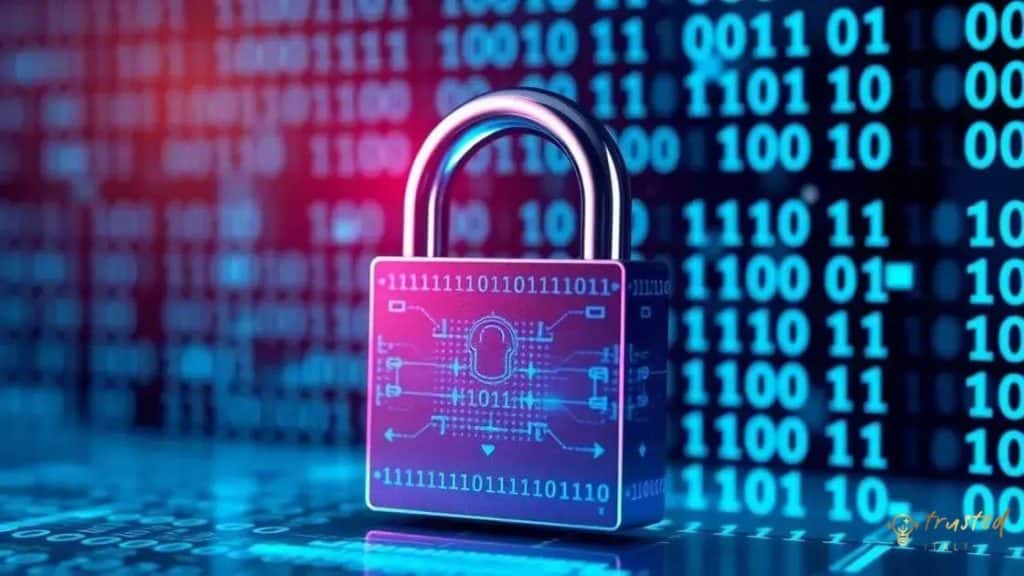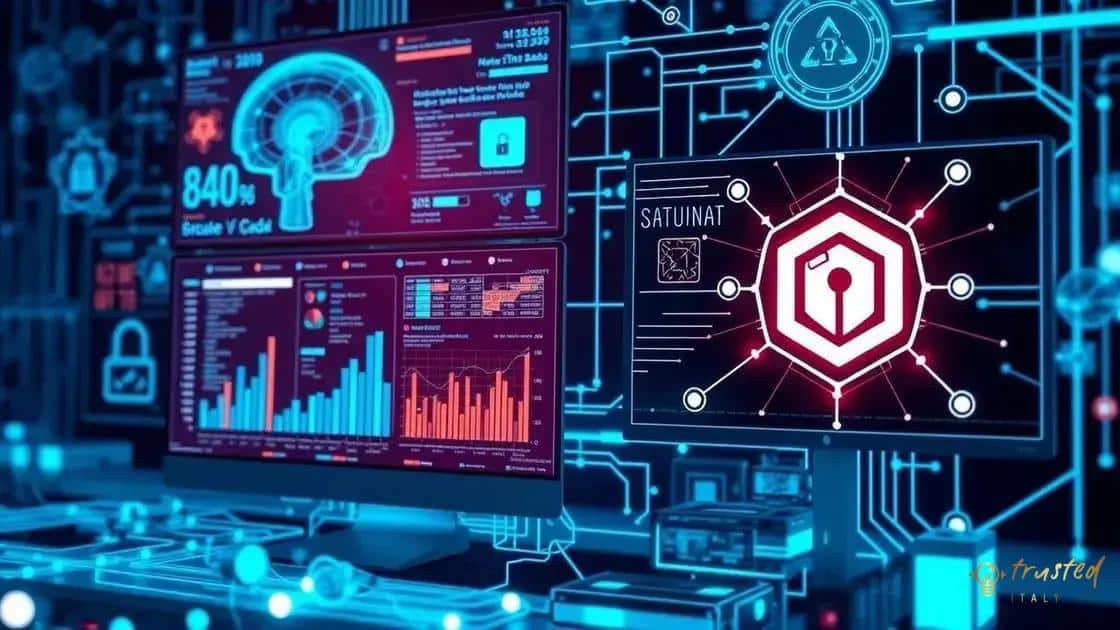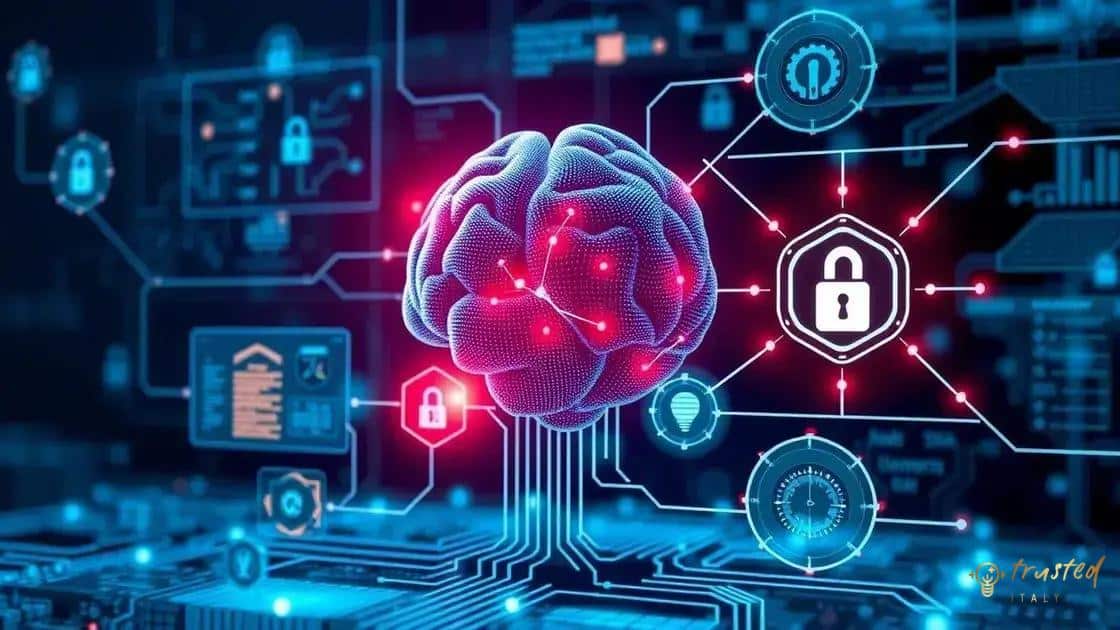Innovations in cybersecurity for protecting personal data

Innovations in cybersecurity for protecting personal data include AI for threat detection, zero trust architecture, and advanced encryption methods, enhancing overall security against evolving digital threats.
Innovations in cybersecurity for protecting personal data have become increasingly essential as we rely more on technology. With data breaches making headlines, how can we ensure our personal information remains secure? Let’s explore some cutting-edge strategies that can help.
Understanding the evolving landscape of threats
In today’s digital world, understanding the evolving landscape of threats is vital for protecting our personal data. As technology advances, so do the tactics of cybercriminals. This continual evolution means that what may have been considered a secure system last year might now be at risk.
Types of Cyber Threats
Cyber threats come in various forms, each posing unique challenges. It’s essential to be aware of these threats to ensure that we take the right precautions.
- Malware: This includes viruses, worms, and trojans that can damage your system.
- Phishing: Cybercriminals impersonate legitimate entities to steal personal information.
- Ransomware: This is when your data is locked until you pay a ransom.
- Denial of Service (DoS): Attacks that overwhelm a network, causing it to crash.
As you can see, the attack surface is broad and constantly changing. Cybersecurity measures need to be adaptable and robust to handle these threats effectively. Ensuring one’s personal data remains safe requires a multifaceted approach.
Emerging Threats
Additionally, new technologies bring new vulnerabilities. For example, the rise of the Internet of Things (IoT) has led to an increase in attacks targeting smart devices. While these devices can improve our lives, they often lack strong security measures.
Cloud computing also presents a unique set of challenges. As more data is stored online, understanding how to protect this data against unauthorized access becomes even more crucial. Regular updates and patches, using strong passwords, and enabling two-factor authentication can be the difference between security and a breach.
It’s clear that as technology evolves, so do the threats surrounding us. This constant change highlights the importance of staying informed and proactive in cybersecurity measures. By recognizing the types of threats and being aware of emerging risks, individuals can take steps to better protect their personal data.
Top innovations transforming cybersecurity

In the realm of cybersecurity, several top innovations transforming cybersecurity have emerged to protect our data from evolving threats. These advancements are crucial for ensuring both individuals and organizations stay one step ahead of cybercriminals.
Artificial Intelligence (AI)
One significant innovation is the use of artificial intelligence. AI analyzes vast amounts of data to identify patterns and detect potential threats in real time. This proactive approach allows for quicker responses, minimizing damage and improving overall security.
- AI systems can learn from previous attacks.
- They adapt to new cyber threats without human intervention.
- AI helps automate repetitive security tasks.
By integrating AI, companies can bolster their defenses and respond swiftly to incidents.
Blockchain Technology
Another game-changer is blockchain technology. Originally designed for cryptocurrencies, blockchain offers security features that improve data integrity and transparency. It minimizes fraud and secures transactions.
With its decentralized nature, blockchain makes it challenging for hackers to manipulate data. This technology can be particularly beneficial in sectors like finance and healthcare, where data security is paramount.
Security Automation
Meanwhile, security automation tools streamline cybersecurity operations. By automating routine processes, these tools save time and reduce the risk of human error. This innovation enables security teams to focus on more complex threats rather than mundane tasks.
These automated systems can quickly react to potential breaches, allowing for a faster and more efficient security protocol.
Additionally, innovations such as improved encryption methods and multi-factor authentication are vital in safeguarding personal data. Enhancing encryption ensures that even if data is intercepted, it remains unreadable without the correct keys. Implementing multi-factor authentication adds another layer, making unauthorized access significantly more difficult.
Best practices for safeguarding personal data
Implementing best practices for safeguarding personal data is essential for everyone in today’s digital age. With increasing incidents of data breaches, knowing how to protect sensitive information is more crucial than ever.
Strong Password Management
Using strong passwords is one of the simplest yet most effective ways to safeguard personal data. A strong password includes a mix of uppercase letters, lowercase letters, numbers, and special characters. Avoid using easily guessed information like birthdays or names.
- Change passwords regularly.
- Use unique passwords for different accounts.
- Consider using a password manager.
These practices help enhance account security significantly.
Enable Two-Factor Authentication
Two-factor authentication (2FA) is another important measure. This adds an extra layer of protection by requiring a second form of verification, like a text message code, in addition to your password. It makes unauthorized access more difficult.
Many services now offer this option, and enabling it can go a long way in thwarting potential breaches. Additionally, be cautious about what personal information you share online, especially on social media.
Sharing too much can lead to identity theft or account hacking. Always review your privacy settings and limit the information accessible to others.
Regular Software Updates
Keeping software and applications updated is vital in ensuring cybersecurity. Regular updates often contain security patches that fix vulnerabilities. Failing to update can leave your devices exposed to malware and other threats.
Just as important is using reputable security software. Antivirus programs and firewalls provide essential protection against various cyber threats. They should be part of your routine cybersecurity practices.
Finally, be mindful of phishing attempts. Cybercriminals often use emails or messages that appear legitimate to trick individuals into revealing personal information. Always verify the source before clicking on links or downloading attachments.
The role of AI in cybersecurity solutions

The role of AI in cybersecurity solutions has become increasingly important as threats have evolved. Artificial intelligence empowers organizations to handle vast amounts of data and respond to potential security incidents much faster.
Threat Detection
AI systems are exceptional at threat detection. They analyze network traffic to identify unusual patterns that may indicate an attack. Traditional security systems can struggle to keep up with the volume of data, while AI can spot anomalies efficiently.
- Machine learning algorithms improve detection rates over time.
- AI can prioritize threats based on severity.
- Patterns identified by AI can lead to quicker incident response.
This means faster reaction times and potentially less damage to the organization.
Automated Responses
Another major advantage of AI in cybersecurity is its ability to automate responses. When a threat is detected, AI systems can take immediate action, such as isolating affected systems or blocking malicious traffic. This automation reduces the workload on human security teams.
As a result, they can focus on more complex tasks that require human judgment. Furthermore, by learning from each incident, AI continues to adapt and enhance its capabilities.
Predictive Analytics
AI also plays a vital role in predictive analytics. By examining historical data, it can predict future threats. This proactive approach allows organizations to strengthen their defenses before attacks occur, making cybersecurity more effective.
Organizations can implement more robust security measures, which they might not have considered otherwise. By anticipating potential vulnerabilities, AI enables companies to stay ahead of cybercriminals.
The integration of AI in cybersecurity solutions is not just a trend; it is a necessary evolution in the field. By adopting AI technologies, companies can significantly improve their security posture while adapting to an ever-changing threat landscape.
Future trends in cybersecurity technology
The future trends in cybersecurity technology are becoming increasingly important as digital threats continue to grow. Advancements in technology are paving the way for innovative solutions that enhance security.
Increased Use of Artificial Intelligence
One major trend is the growing reliance on artificial intelligence for threat detection and response. AI is capable of analyzing data at incredible speeds, identifying potential threats faster than traditional methods.
- Machine learning algorithms help systems learn from past breaches.
- AI can automate responses, reducing the time to mitigate risks.
- Predictive analytics can forecast attack patterns.
This evolution allows companies to adapt their security measures continuously.
Zero Trust Architecture
Another significant trend is the shift towards a zero trust architecture. This model assumes that threats could emerge from both internal and external sources, thus requiring verification from everyone trying to access resources, regardless of their location.
Zero trust requires strong identity verification, limiting access based on user identity and context. Implementing this architecture helps organizations minimize the risk of unauthorized access.
Extended Detection and Response (XDR)
The adoption of Extended Detection and Response (XDR) is on the rise. XDR integrates different security products into a cohesive defense strategy. By centralizing detection and response capabilities, security teams can respond more effectively across diverse environments.
XDR provides a more comprehensive view of threats, improving the ability to react quickly and effectively to security incidents. Furthermore, automation plays a key role in improving response times.
Lastly, advancements in quantum computing are expected to transform cybersecurity. Quantum computing promises enhanced encryption methods that can protect sensitive data against advanced threats. As technology continues to evolve, understanding these trends becomes essential for organizations aiming to protect their digital assets.
FAQ – Frequently Asked Questions about Innovations in Cybersecurity
What are the main innovations in cybersecurity today?
Key innovations include artificial intelligence for threat detection, zero trust architecture, and advanced encryption methods.
How can I protect my personal data effectively?
Using strong passwords, enabling two-factor authentication, and remaining cautious about sharing personal information are essential steps.
What is zero trust architecture, and why is it important?
Zero trust architecture assumes that threats can come from anywhere, requiring verification for every user accessing resources, enhancing security.
How does AI improve cybersecurity solutions?
AI enhances cybersecurity by identifying threats quickly, automating responses, and using predictive analytics to anticipate potential attacks.